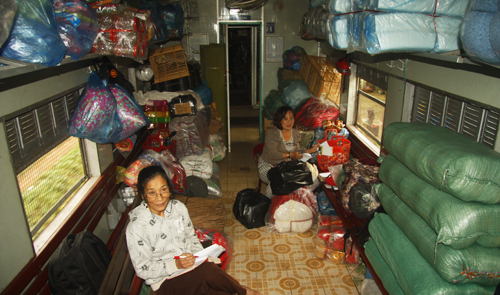Train fares in some localities in Vietnam are unbelievably cheap now, in contrast to the current complaints that the cost to travel by train in the nation is equivalent to airfares. Both are fact.
Apart from the express trains between Hanoi and Ho Chi Minh City with the fares as expensive as traveling by air, Vietnam has dozens of other railway routes to connect neighboring provinces with surprisingly low fares.
They are commonly called local trains or ‘market’ trains. In colloquial Vietnamese, 'market' is translated as 'chợ' which means 'cheap'.
Low fares
The cost of traveling on a ‘market’ train for a distance of 166km from Hue to Dong Hoi of Quang Binh Province in the central region is even cheaper than two phở (noodle soup) bowls, only VND40,000 (US$1.9) a passenger.
The fare for transporting 100kg of cargo over a similar route is just over a US dollar, or VND27,000.
For decades, the ‘market’ trains have been the main means of transport for wholesalers to collect and distribute goods to and from remote areas.
In short, the trains help the flow of free trade among different localities, especially in mountainous areas with a sparse population.
Ms. Nguyen Thi Kim Hoa is one of the wholesale traders between Hue and Quang Binh and so, a regular commuter of a ‘market’ train numbered ĐH41.
“The train fare is dirt-cheap. I only pay slightly over VND100,000 for my passenger ticket and for several hundreds of kilograms of cargo to be transported on this train,” she told a Tuoi Tre journalist.
She said she has commuted on the 'market’ train connecting Hue and Quang Binh for 37 years, and has witnessed many changes to the train, except for two things: the train fare and the speed.
The fare to go between the two ends of the train route has never been more expensive than the cost of two phở bowls and the speed of the train has remained unchanged at 30kph, she added.
Sometimes, the consuming rate has lowered but traders have pursued their job of delivering goods to local retail markets thanks to the low train fare, Hoa said.
On another ‘market’ train in the central region from Dong Hoi of Quang Binh to Vinh in Nghe An Province, the fare to transport 300kg of firewood for around 100km is VND30,000 ($1.5).
Chau Nam Trung, head of the railway station Hoa Duyet on the route, said, “100kg of firewood can be sold at VND50,000 in Vinh. The railway industry collects fare for formalities' sake as locals here can’t afford to pay higher.”
Because of the low fares, the state budget has to cover the loss of ‘market’ trains working on the ‘subsidized’ rail routes.
Concretely, the financial loss of the five ‘market’ trains was VND83 billion ($4 million) in 2011 and VND103 billion ($5 million) in 2012.
As a result, the Vietnam Railways Corporation proposed last year stopping the operations of ‘market’ trains on five routes in the central and northern regions for business loss.
But authorities of the local provinces where the five train routes go through protested it as it would badly affect normal life of local people in remote areas.
The operation of the trains is still under way now, waiting for new decisions in the future.
The ‘market’ trains a rhythm of life in remote areas
Daily activities and lives of residents in remote areas have been dependent on the operation of these trains.
On only 180km between the two terminals of the rail route Hue – Dong Hoi, there are 20 ‘market’ train stops.
It takes a ‘market’ train 15-20 minutes to go from this stop to the next, around 9-10km from each other.
Railway officers and local commuters have got familiar with one another and they often chat and ask after their health on getting on a train.
Many residents prefer the train to travelling by bus so that they can meet their friends who they have become close to thanks to the ‘market’ trains.
Ms. Hoa, the wholesaler, recalled a story of the close relationship between rail officers and passengers.
A ‘market’ train travelling between Hue and Dong Hoi was stuck in a severe flood in 1999 for four days but hundreds of passengers were provided with hot rice and instant noodles although many of them had no money.
They offered food on credit. After the flood water receded, the train continued its journey and the passengers went home. Around a week later, they returned to take the train and paid for all their food.




















































